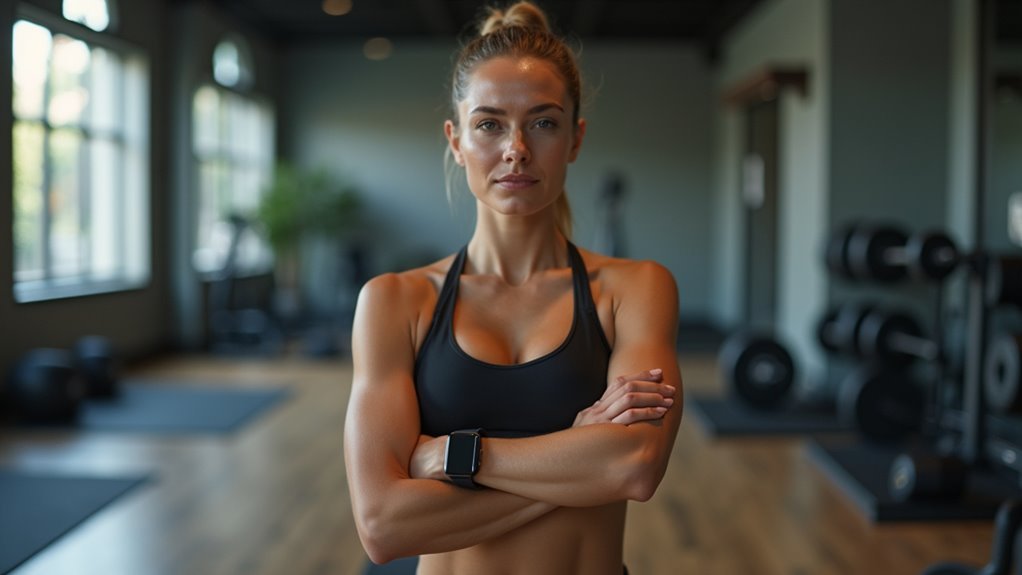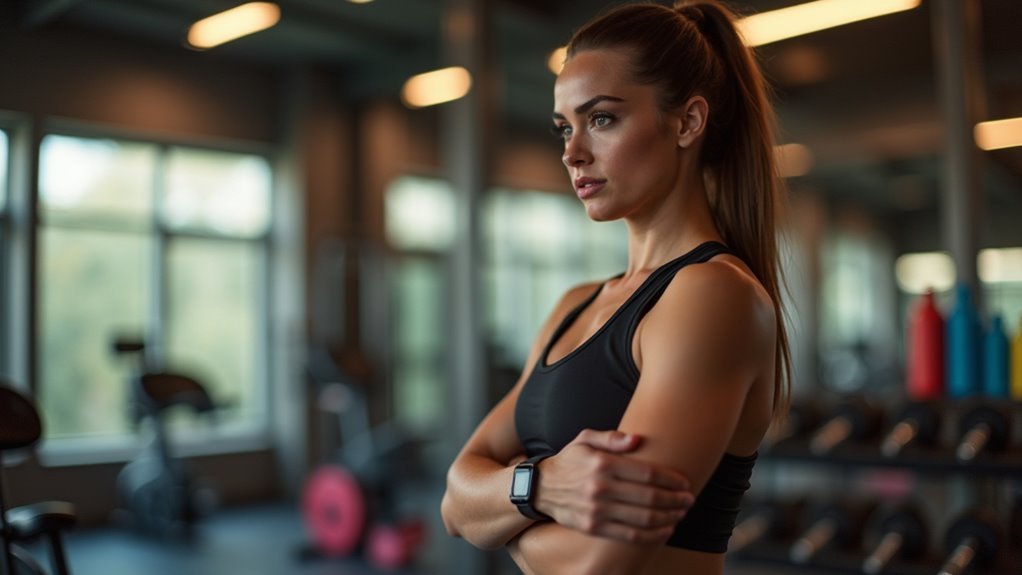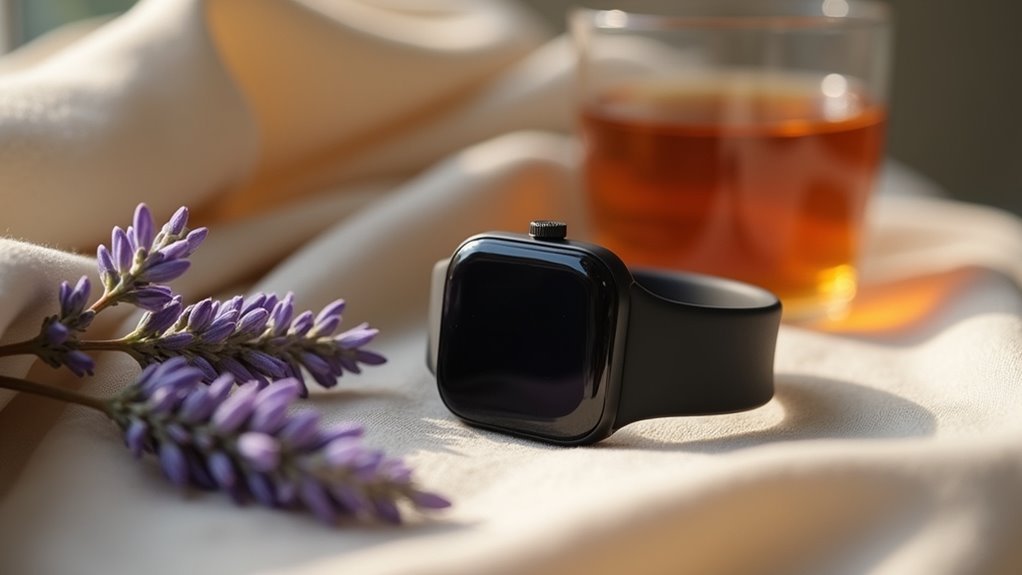Hormone tracking wearables continuously monitor your heart rate, skin temperature, and other physiological markers throughout your menstrual cycle, using machine learning to identify hormonal phases and fertile windows. They help you optimize training performance by adjusting workout intensity based on your cycle—recommending higher intensity during your follicular phase and active recovery during your luteal phase. These devices also prevent injuries by tracking hormonal fluctuations that affect movement patterns and joint stability, giving you personalized insights that enhance your athletic development and long-term performance goals.
How Hormone Tracking Wearables Monitor Female Physiological Changes
Revolution in athletic performance monitoring has arrived through hormone tracking wearables that continuously capture the intricate physiological changes occurring throughout a female athlete’s menstrual cycle.
Your wearable device tracks multiple physiological parameters simultaneously—heart rate, skin temperature, respiratory rate, heart rate variability, and skin perfusion—all of which fluctuate with your hormonal changes.
These devices generate extensive longitudinal datasets that reveal your personalized menstrual patterns. You’ll receive real-time data about your wellness and training readiness based on your current hormonal status.
Advanced machine learning algorithms analyze these multi-modal signals to accurately identify your menstrual phases and fertile windows.
Some cutting-edge wearables now detect specific hormones like estradiol through sweat analysis using microfluidic channels and conductive nanomaterials, providing direct hormone monitoring rather than relying solely on indirect physiological signals. This technology addresses the critical gap where only 6% of sport science research has focused exclusively on women, helping to reduce the higher injury burden that female athletes face due to training methods based primarily on male physiology.
Optimizing Training Performance Through Menstrual Cycle Data
When you analyze your menstrual cycle data alongside training metrics, you’ll discover powerful insights that can transform your athletic performance. Your perceived performance often dips during early follicular and late luteal phases, though objective data shows no consistent measurable impact across all athletes.
You can use wearables and apps that track cycle length, symptoms, and physiological markers, then integrate this data with your training logs. Many elite teams now use menstrual-cycle-oriented dashboards for thorough athlete monitoring.
While you might feel performance drops in certain phases, these subjective experiences don’t always correlate with actual performance metrics. You’ll benefit from daily questionnaires and feedback that guide training adaptations, allowing you to harness natural hormonal fluctuations for optimized results. Understanding these patterns can also help with injury prevention by adjusting training intensity during vulnerable phases of your cycle.
Injury Prevention Benefits of Hormonal Fluctuation Insights

Beyond optimizing performance, your hormone tracking data serves as a powerful tool for preventing injuries before they occur.
When estrogen and progesterone fluctuate during your menstrual cycle, they directly affect your biomechanics and movement patterns, particularly during the late follicular phase.
These hormonal changes can disrupt your neural control of movement and alter collagen fiber structure, reducing joint stability and increasing your risk of ACL tears, stress fractures, and tendonitis. Research shows that female athletes face a 2.8 times greater chance of ACL injuries compared to their male counterparts.
Leading Wearable Technologies for Women’s Hormone Monitoring
The landscape of hormone monitoring has transformed dramatically with the emergence of cutting-edge wearable technologies designed specifically for women’s health needs.
Revolutionary wearable technology is reshaping how women monitor their hormones, delivering unprecedented insights into reproductive health and wellness patterns.
You’ll find advanced options like flexible microfluidic patches that detect estradiol through your sweat in real-time, using gold nanoparticles and titanium carbide films for enhanced accuracy.
Wearable rings such as the Oura Ring track your sleep and recovery patterns correlated with menstrual phases, while portable devices like the Mira Hormone Monitor provide lab-level precision in measuring LH and estrogen from urine samples.
These technologies offer AI-powered fertility tracking that adapts to irregular cycles and PCOS conditions.
You can now access continuous, wireless hormone monitoring that transforms your understanding of hormonal fluctuations and their impact on athletic performance. This advancement addresses the growing demand for accessible monitoring alternatives to traditional clinic-based blood draws and mail-in laboratory testing.
Recovery and Training Personalization Based on Hormonal Phases

As hormone tracking wearables capture real-time physiological data, you’re now able to revolutionize your training approach by aligning workouts with your body’s natural hormonal rhythms. These devices monitor heart rate variability, sleep quality, respiration rate, and skin temperature to identify patterns across your menstrual cycle phases.
| Cycle Phase | Training Recommendations |
|---|---|
| Follicular | Higher intensity and volume; leverage improved endurance and recovery |
| Luteal | Active recovery, stretching, lighter workouts to accommodate decreased energy |
| Menstruation | Prioritize rest and low-impact activities for ideal recovery |
Your wearable dynamically adjusts daily strain recommendations, preventing overreaching during vulnerable phases while maximizing performance when you’re physiologically ready. This personalization reduces injury risk and supports long-term athletic development. The data analysis from these devices helps identify trends in strength, endurance, and recovery that can assist in preventing ACL injuries among women athletes.
Frequently Asked Questions
How Much Do Hormone Tracking Wearables Typically Cost for Athletes?
You’ll typically spend $100 to $300 for hormone tracking wearables, plus monthly or annual subscription fees. You should budget for both initial costs and ongoing subscriptions when choosing your device for ideal performance tracking.
Are Hormone Tracking Wearables Accurate Compared to Laboratory Blood Tests?
You’ll find hormone tracking wearables are generally less accurate than laboratory blood tests, but they offer continuous monitoring and convenience that lab tests can’t provide for daily training optimization.
Do These Wearables Work for Athletes With Irregular Menstrual Cycles?
Wearables can help you manage irregular cycles by identifying patterns through real-time data, but you’ll need personalized approaches since unpredictable hormone fluctuations make tracking more challenging than regular cycles.
Can Hormone Tracking Wearables Be Used During Pregnancy for Athletes?
You can use hormone tracking wearables during pregnancy to monitor heart rate, sleep patterns, and exercise intensity. However, there’s limited research on their safety and effectiveness for pregnant athletes specifically.
What Privacy Concerns Exist With Hormone Data Collected by Wearables?
Your hormone data faces unauthorized access risks, potential discrimination in sports, and varying protection standards across apps. You’re vulnerable to privacy violations, especially if you’re transgender, since mandatory tracking can conflict with constitutional rights.




Leave a Reply